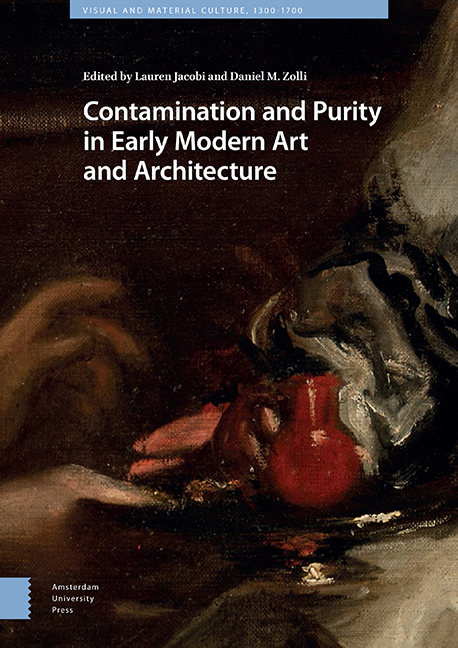Book contents
- Frontmatter
- Contents
- List of Illustrations
- Introduction: Contamination and Purity in Early Modern Art and Architecture
- 1 Generation and Ruination in the Display of Michelangelo’s Non-finito
- 2 The Sacrilege of Soot: Liturgical Decorum and the Black Madonna of Loreto
- 3 Sedimentary Aesthetics
- 4 ‘Adding to the Good Silver with Other Trickery’ : Purity and Contamination in Clement VII’s Emergency Currency
- 5 Tapestry as Tainted Medium: Charles V’s Conquest of Tunis
- 6 Bruegel’s Dirty Little Atoms
- 7 Leakage, Contagion, and Containment in Early Modern Venice
- 8 Contamination, Purification, Determinism: The Italian Pontine Marshes
- 9 Colonial Consecrations, Violent Reclamations, and Contested Spaces in the Spanish Americas
- 10 Contamination | Purification
- Index
Introduction: Contamination and Purity in Early Modern Art and Architecture
Published online by Cambridge University Press: 27 May 2021
- Frontmatter
- Contents
- List of Illustrations
- Introduction: Contamination and Purity in Early Modern Art and Architecture
- 1 Generation and Ruination in the Display of Michelangelo’s Non-finito
- 2 The Sacrilege of Soot: Liturgical Decorum and the Black Madonna of Loreto
- 3 Sedimentary Aesthetics
- 4 ‘Adding to the Good Silver with Other Trickery’ : Purity and Contamination in Clement VII’s Emergency Currency
- 5 Tapestry as Tainted Medium: Charles V’s Conquest of Tunis
- 6 Bruegel’s Dirty Little Atoms
- 7 Leakage, Contagion, and Containment in Early Modern Venice
- 8 Contamination, Purification, Determinism: The Italian Pontine Marshes
- 9 Colonial Consecrations, Violent Reclamations, and Contested Spaces in the Spanish Americas
- 10 Contamination | Purification
- Index
Summary
‘Dirt offends against order.’ With this assertion, appearing on the first page of her now-classic study on pollution, the British social anthropologist Mary Douglas announced her conviction that attending to dirt – or, more precisely, the aversion to it – could afford uncommon insight into how societies understood, assembled, and produced order. Published in 1966, Purity and Danger: An Analysis of Concepts of Pollution and Taboo offered a potent structural analysis of cultural notions of cleanliness. Those empowered to define dirt not only determined social norms, Douglas argued, but they distinguished what (or who) fell within those norms from what did not. To create rules about ‘dirt’ then – an elastic metaphor, in Douglas's schema, referring to ‘all the rejected elements of ordered systems’ – was to define order, a categorization dependent, necessarily, on the transgressive status of dirt: deemed restless, volatile, ready to chip away at order's defenses. Like binary stars locked in a gravitational orbit, contamination and purity were, for Douglas, always inseparably dependent.
The present volume partly grows from a belief that Douglas's insights can be productively extended into the study of early modern Europe. To be sure, early modern Europeans were not the first, nor the last, people for whom contamination and purity were preoccupations that structured culture. One of Douglas's points, in fact, is that pollution-consciousness is a hallmark of many societies seeking to construct social order: her own examples, from the Hebrews following Leviticus to the Lele people of sub-Saharan Africa to her own postwar Britain, capture this. Nevertheless, it is demonstrably the case that throughout the European subcontinent roughly between the years 1400 and 1750 CE questions surrounding what was pure and impure – distinctions between the clean and unclean, sameness and difference, self and other, organization and its absence – were of paramount concern.
The Latin word contaminare comes from com-tangere (‘to touch or bring together’). The word suggests tactility, contact, and – etymologically at least – it excludes purity, depending on one entity's exposure to, its mixing with, outside or foreign influences. During this period, Europe saw vast numbers of bodies and things in motion. It witnessed not only increased trade, but European exploitation and exploration unfolded on a hitherto unimaginable scale, not to mention frequent irruptions of disease, as the very channels along which people, objects, and ideas circulated also carried dangerous pathogens.
- Type
- Chapter
- Information
- Publisher: Amsterdam University PressPrint publication year: 2021

